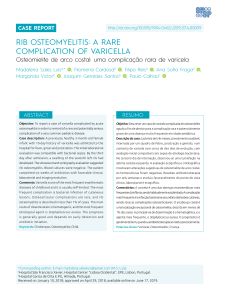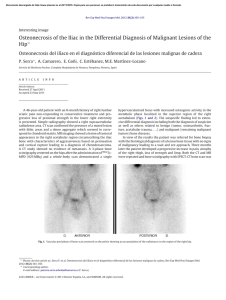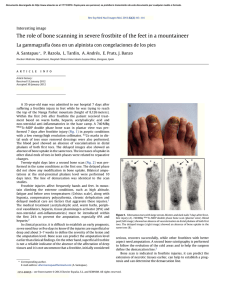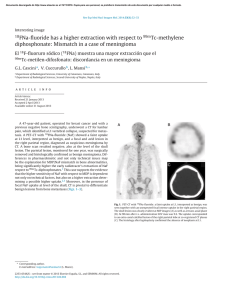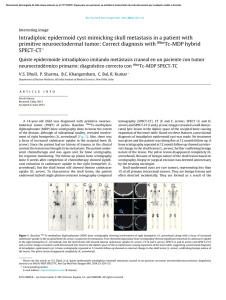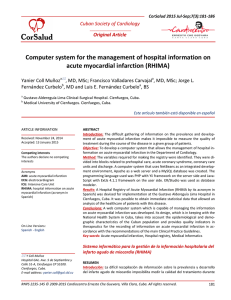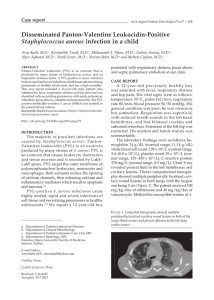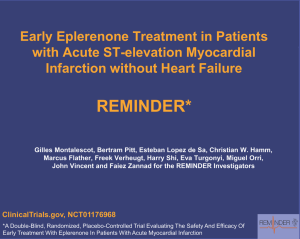Acute Osteomyelitis in Children: Pathogenesis Revisited
Anuncio
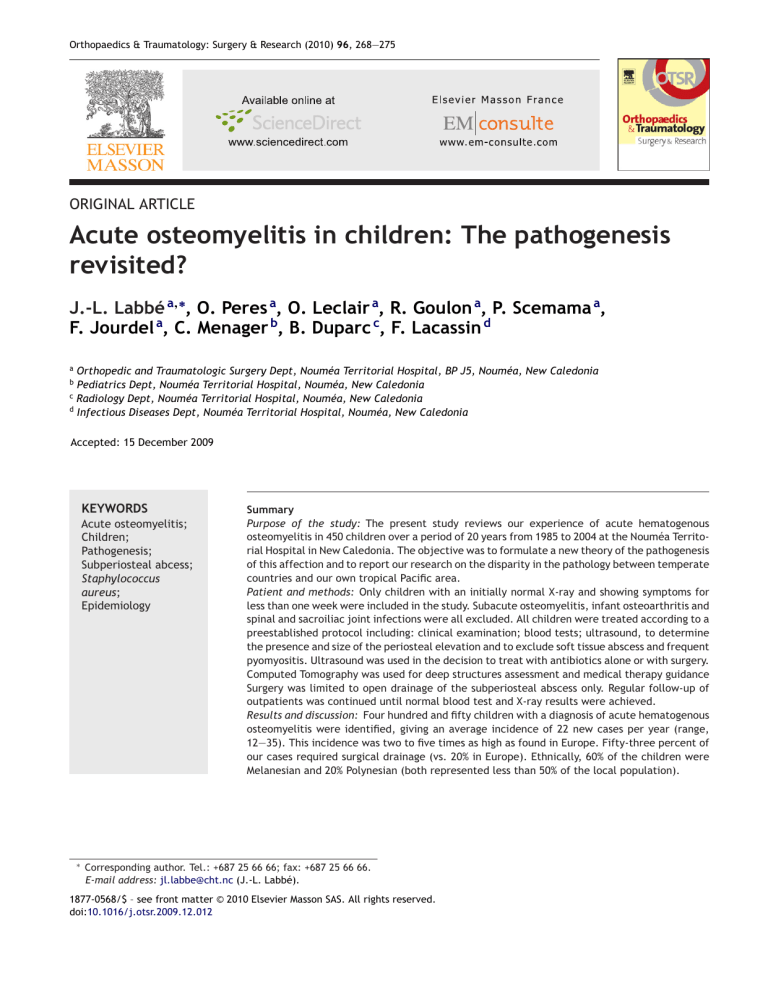
Orthopaedics & Traumatology: Surgery & Research (2010) 96, 268—275 ORIGINAL ARTICLE Acute osteomyelitis in children: The pathogenesis revisited? J.-L. Labbé a,∗, O. Peres a, O. Leclair a, R. Goulon a, P. Scemama a, F. Jourdel a, C. Menager b, B. Duparc c, F. Lacassin d a Orthopedic and Traumatologic Surgery Dept, Nouméa Territorial Hospital, BP J5, Nouméa, New Caledonia Pediatrics Dept, Nouméa Territorial Hospital, Nouméa, New Caledonia c Radiology Dept, Nouméa Territorial Hospital, Nouméa, New Caledonia d Infectious Diseases Dept, Nouméa Territorial Hospital, Nouméa, New Caledonia b Accepted: 15 December 2009 KEYWORDS Acute osteomyelitis; Children; Pathogenesis; Subperiosteal abcess; Staphylococcus aureus; Epidemiology ∗ Summary Purpose of the study: The present study reviews our experience of acute hematogenous osteomyelitis in 450 children over a period of 20 years from 1985 to 2004 at the Nouméa Territorial Hospital in New Caledonia. The objective was to formulate a new theory of the pathogenesis of this affection and to report our research on the disparity in the pathology between temperate countries and our own tropical Pacific area. Patient and methods: Only children with an initially normal X-ray and showing symptoms for less than one week were included in the study. Subacute osteomyelitis, infant osteoarthritis and spinal and sacroiliac joint infections were all excluded. All children were treated according to a preestablished protocol including: clinical examination; blood tests; ultrasound, to determine the presence and size of the periosteal elevation and to exclude soft tissue abscess and frequent pyomyositis. Ultrasound was used in the decision to treat with antibiotics alone or with surgery. Computed Tomography was used for deep structures assessment and medical therapy guidance Surgery was limited to open drainage of the subperiosteal abscess only. Regular follow-up of outpatients was continued until normal blood test and X-ray results were achieved. Results and discussion: Four hundred and fifty children with a diagnosis of acute hematogenous osteomyelitis were identified, giving an average incidence of 22 new cases per year (range, 12—35). This incidence was two to five times as high as found in Europe. Fifty-three percent of our cases required surgical drainage (vs. 20% in Europe). Ethnically, 60% of the children were Melanesian and 20% Polynesian (both represented less than 50% of the local population). Corresponding author. Tel.: +687 25 66 66; fax: +687 25 66 66. E-mail address: jl.labbe@cht.nc (J.-L. Labbé). 1877-0568/$ – see front matter © 2010 Elsevier Masson SAS. All rights reserved. doi:10.1016/j.otsr.2009.12.012 Acute osteomyelitis in children: The pathogenesis revisited? 269 A similar incidence, about four times as high as in the population of European descent, was reported in Polynesians by our neighbors in New Zealand. The limbs were affected in 90% of cases, and specifically lower limbs in 70%. Multiple osseous lesions and systemic infection were recorded in 43 children (9.5%). Blood cultures and surgical samples were positive in 80% of cases, and otherwise negative. All the children were successfully treated, without chronic evolution or sequelae needing secondary surgery. The predominant microorganisms isolated were Staphylococcus aureus, in 81% of cases, none of which were methicillin-resistant, and group A Streptococcus in 7.5% of cases. A previous study of soft-tissue S. aureus infection showed the presence of Panton-Valentine Leukocidin (PVL) genes in 89% of cases. These very infrequent genes are responsible for leukotoxic apoptosis, producing leukocidin, causing local acute aggressiveness. A parallel study, in progress for more than a year, is focusing on detecting PVL genes in S. aureus isolated from acute osteomyelitis: in the first nine children analyzed, PVL genes were likewise detected in 89% of the S. aureus isolated, with no methicillin resistance. Ultrasonography allowed positive diagnosis in 64% of cases on the day of admission and 84% by the second day. Because of this very early presence of subperiosteal abscess at the beginning of the disease, and several other issues raised in the present study, we believe that Trueta’s theory of acute osteomyelitis pathogenesis does not provide any logical explanation for our anatomoclinical observations. We believe that the primary focus of infection is in the osteoperiosteal area rather than under the growth plate in the metaphyseal bone. The term of Acute Osteo-Periostitis would therefore be much more suitable. A history of blunt trauma was found in 63% of cases in the present series, and often reported in the literature. We speculate that two forms of infection fixation may develop: a local form, where bacteria carried by the blood stream reach a subperiosteal edema or hematoma secondary to blunt trauma, which is in our opinion the most frequent cause; and a general form, where fixation occurs as single or multifocal osteoperiostitis, and multivisceral locations in severe forms of septicemia. The disparity in this pathology between temperate countries and our own tropical Pacific area is certainly due to PVL-positive S. aureus and ethnic factors. The high prevalence of Melanesian and Polynesian patients confirms that they are at high risk of musculoskeletal infection in New Caledonia as in other Pacific countries, and it is possible that these ethnic groups are genetically susceptible to PVL-positive strains. Level of evidence: Level IV. Retrospective case series. © 2010 Elsevier Masson SAS. All rights reserved. Introduction We present our clinical, paraclinical and therapeutic experience of a 20-year series of 450 children with acute osteomyelitis managed in the pediatric and orthopedic surgery departments of the Nouméa Territorial Hospital in New Caledonia. The results of these studies, taken as a whole, did not verify Trueta’s theory [1] regarding the pathogenesis of this disease. Furthermore, several important questions raised during our studies could not be addressed by Trueta’s theory. We therefore provide the basis for a possible new theory of the pathogenesis, consistent with our findings and able to provide answers to these questions. We also present our epidemiological research and results, to shed light on the disparities in pathology between our own tropical Pacific region and temperate countries. Patient and methods The series This study reviewed children treated between 1985 and 2004 for acute osteomyelitis with less than 1 week’s evolution and normal initial standard X-ray. Cases of subacute and chronic forms, infant osteoarthritis, sacroiliitis and spondylodiscitis and those few managed solely in intensive care and who died following multiple osseous and visceral involvement were not included. Four hundred and fifty patients were thus recruited, with a mean incidence of 22 per year (range, 12—35). The most affected ethnic groups were Melanesian (60%) and Polynesian (20%); both represented less than 50% of our population. Mean age was 8.2 years (range, 3 months—15 years); males predominated (62%) The youngest patient (3 months) presented with femoral pandiaphysitis. Management Now that the medical and nursing staff in all the health centers and hospitals in New Caledonia are receiving regular training, patients were examined during the first week after the onset of localized symptoms. For a very small minority of children, mainly from isolated tribes or islands outside the territory of New Caledonia, however, treatment begins only at the chronic osteomyelitis stage, and sometimes with considerable delay, entailing fistulae and fractures. At emergency admission, all children have been managed by the same protocol during these 20 years: 270 Figure 1 (a) Ultrasonography aspect of a periosteal elevation, showing precise location and size, (b) computed tomography was more efficient for deep structures such as the back of the distal femur, (c) and the pelvis. • following clinical and biological assessment, comprising complete blood count (CBC), erythrocyte sedimentation rate (ESR), fibrinogen (FIB), C-reactive protein (CRP) and blood cultures, the affected limb was immobilized in a splint ahead of immediate ultrasonography. Standard X-ray of the affected bone segment was systematically performed. The child was then admitted to hospital and administered an initial course of bi-antibiotherapy associating cefazolin and gentamycin. Clinical examination consistently found a chief complaint of swellings in one limb segment, failure to use the extremity, and limp, in a general context of infection and hyperalgesia; • ultrasonography, performed by an experienced operator, enabled immediate positive diagnosis from (a) the pathognomic aspect of subperiosteal abscess, further specifying volume and precise location (Fig. 1a), and differential diagnosis with respect to soft-tissue abscess and especially to myositis, which is frequent in this part of the world. In case of certain deep locations (pelvic) or very limited subperiosteal abscess (posterior side of the distal femoral metaphysis) or of difficulty in US scan interpretation, a CT scan was performed (Fig. 1 b—c). Axial slices with sagittal and coronal reconstruction using contrast injection if need be, provided consistent visualization of the periosteal elevation, enabling differential diagnosis with respect to deep abscess in the earlier stages. Bone scan and MRI were not used during the study period. On US diagnosis, either the periosteum showed an aspect of slight elevation of small volume with little vertical and circumferential extension, in which case management was by antibiotics alone with regular US follow-up until regression was obtained; or else elevation volume was considered more severe, and surgery was indicated. Surgery likewise followed a standard design: J.-L. Labbé et al. • the surgical approach was directly onto the abscess. The periosteum was incised, unless already ruptured; pus was evacuated by lavage and drainage of the cavity between the cortical bone and periosteum. Several samples were taken for bacteriological research and antibiogram specification. The affected metaphysis itself never underwent surgical approach by cortical fenestration or cancellous bone curettage. The limb was immobilized in a circular plaster cast, including the joints above and below the lesion; • postoperatively, iv bi-antibiotherapy was maintained until the temperature curve normalized, generally during the first postoperative week, then converted to oral monotherapy. Antibiotics were adapted in line with the antibiogram as soon as positive bacteriological results were obtained on the samples. Pristinamycin was prescribed in monotherapy in case of Staphylococcus aureus. Biological evolution (CBC, ESR, FIB, CRP) was monitored weekly. The children were not discharged until the surgical wound healed and general health status recovered; • the children were followed up in monthly joint pediatric medicosurgical consultation, with infection and standard X-ray assessments, checking treatment adherence and the condition of the cast. Antibiotherapy was prolonged until all biological parameters, including ESR, normalized. The cast was kept in place until the bone of the affected segment showed sufficient corticalization. No stereotyped therapeutic attitude was imposed, so that each child could be followed up according to their individual pattern of evolution. Results Series Osteomyelitis was situated (Fig. 2) mainly in the lower limbs: 70% (all lesions), versus 20% for upper limbs. The lower Figure 2 Sites of osteomyelitis. (R: radius; U: ulna; T: tibia; F: fibula). Acute osteomyelitis in children: The pathogenesis revisited? 271 leg segment was most frequently involved, at 39.5% of all locations (tibia, 32.3%; fibula 7.2%). The femur and tibia accounted for 58% of all general locations. In upper limb involvement, the humerus was the most frequently affected segment (11.4%). Severe forms, with multiple loci, affected 43 children (9.5%), 28 of whom required prolonged intense care for acute septicemia with multivisceral (mainly pulmonary) involvements; mean age in these cases was younger, at 5 years (vs. 8.2 yrs). An entry point was suspected in 16% of cases; initial blunt trauma could be specified in 63%.Blood culture alone performed at admission was positive in 55% of patients. Blood culture associated with surgical drainage cultures was positive in 80% of cases; 20% of the children, however, had negative bacteriological findings. Of the different organisms retrieved, S. aureus was predominant, at 81% of all cases, followed by group A Streptococcus in 7.5%, and Haemophilus influenzae, Pneumococcus and Staphylococcus epidermidis in 2.8% each. Rarely, in 3.1% of cases, we found an association of Acinetobacter, Enterobacter cloacae and Klebsiella (Kingella kingae was not screened for at the time of the study.)S. aureus resistance to penicillin G has been spreading over the years in New Caledonia and is now at European levels (> 70%). No methicillin-resistant S. aureus (MRSA), however, was found, unlike reports from our neighbors in Auckland, New Zealand, of a 20% rate of MRSA [2]. In a preliminary study on surgically drained communityacquired soft tissue abscesses, S. aureus was detected in 72%. S. aureus nasal carriage was detected in 39.7% of patients with S. aureus infections. Fifty-four S. aureus isolates were screened for toxin genes, and Panton-Valentine leukocidin (PVL) genes were detected in 89% [3]. Comparatively, less than 2% of consecutive strains isolated in France were PVL-positive, and these always methicillin-resistant [4]. PVL genes induce leukotoxic leukocidin production, causing acute locally aggressive infection [5]. A parallel study that has been underway for a year is screening for PVL genes in S. aureus in osteomyelitis: in the first nine children examined, PVL genes were found in eight of the S. aureus, all methicillin-sensitive. any point between two extremes: single bone location with slight periosteal elevation, managed medically; or acute septicemia with multivisceral and multiple osseous involvements, managed by prolonged intensive care. Thus, the length of treatment varied from 1 to 9 months (mean = 4 months). No cases of epiphysiodesis or other evolutive sequelae were observed. In some cases (18 %), there was bone lengthening (< 1 cm) or tibial valgus (< 10◦ ), never severe enough to require secondary surgical correction. Imaging and treatment Bone ultrasonography has been used in our department in this pathology since 1985. Peyrot, in a Master’s thesis (Montpellier University, France, May 1988), demonstrated the determining role of this noninvasive examination for early positive and differential diagnosis of osteomyelitis in the first 37 children of the present series. For the 450 children finally reviewed, positive diagnosis was made at D1 in 64% and by D2 in 84% of cases. CT scan consistently confirmed US diagnosis. It was prescribed in 18% of the present series, either in first intention or due to unclear US findings. Standard X-ray confirmed bone signs as of D16, on average. Surgery (primary and one-step) was performed in 52.8% of children. Acute osteomyelitis, treated without delay, was cured in all cases, with no chronic evolution. Recovery time varied greatly from one child to another, depending on the context of the disease, at Discussion This discussion will focus first on pathogenesis, then on epidemiology. Pathogenesis Pathogenetic theory and review of the literature Ever since its publication in 1959, Trueta’s ‘‘The three types of acute haematogenous osteomyelitis’’ [1] has remained the reference for the pathogenesis of the disease. Trueta, following Hobo [6], described an infection located and developing in a system of ‘‘blood lakes’’ beginning at the intrametaphyseal capillary loop under the growth plate, where flow is slower. Branches of the nutrient artery, and finally the artery itself, are ‘‘secondarily thrombosed by spreading infection from the venous side of the loops’’, although specifying: ‘‘bone infection does not occur initially along the periosteal and metaphysial vessels’’. Due to the edema caused by ‘‘extensive involvement of the metaphysial veins. . . transudates expand towards the surface of the bone across the cortex, where it is thinnest, over the distal part of the metaphysis, and here the periosteum is raised from the cortex, disrupting all vascular connections between them.’’ The exsudate becomes pus, and ‘‘the periosteum lays down a new layer of bone — the involucrum — at some distance from the cortex.’’ The resulting internal, then external ischemia, then induces cortical bone necrosis, responsible for large sequestrae. Trueta stressed that the presence of the growth cartilage barrier provides protection both for the epiphysis itself and for the joint from the spread of infection, and that this was not the case in infants, in whom the vascular system crosses the barrier.Since Trueta’s initial work, several authors [7,8] have pointed out that growth cartilage provides only a relative barrier. Metaphyseal sepsis may spread to the joint, via the subperiosteal space close to the epiphysis. In this sense, acute osteomyelitis, septic childhood arthritis and infant osteoarthritis may be said to be one and the same disease entity.Darville and Jacobs [9] classified osteomyelitis evolution into four stages, each with its treatment indications. Essadam and Hammou [10] drew up the ‘‘Tunis protocol’’, specifying treatment according to stage of evolution, based on ultrasonography performed as of D1; surgery is indicated at stage 2, with the onset of the subperiosteal abscess.Starr, in 1922 [11], showed that the individual’s ‘‘general resistance’’ to bacterial aggression allows intrametaphyseal infection to develop or not. More recently, the notion of closed direct trauma has been revived by Morrissy and Haynes [12], as a ‘‘focalizing’’ agent in the etiology of the pathology.Lew and Waldvogel [13] compared and demonstrated the interest of CT and 272 MRI: the latter is especially effective in early detection of the ‘‘intra-osseous edema’’, and may reduce indications for bone scans in the future. Reflections on pathogenesis Based on our own clinical laboratory-imaging procedures and therapeutic observations, a number of questions with regard to the above theory have been raised: • How can our consistent US and CT finding of a subperiosteal abscess in the early acute phase be accounted for? The process set out by Trueta is too long to explain the immediate discovery of subperiosteal abscess. Transudate would have to pass through healthy cortical bone, as hypothesized by Trueta but never demonstrated experimentally. Anatomically, transudate could cross the metaphyseal cortex only via the transverse Volkmann canals, connecting the longitudinal Havers canals. These canals have a mean diameter of 50 m, with blood vessels taking up most of the intracanal volume and inflammation further restricting permeability, especially for transudation with so high a flow-rate. Moreover, why would the exsudate not spread to the diaphyseal cavity, which would require less pressure than crossing the cortical barrier? Ficat and Arlet’s [14] phlebographic exploration of bone vascularization in aseptic osteonecrosis of the hip demonstrated that venous drainage following efferent vein thrombosis was via reflux towards the diaphysis, as our present hypothesis contends. Trueta’s cortical transudation as the mechanism of periosteal elevation is, in our opinion, scientifically dubious. How can we explain the pathogenesis of pandiaphysitis with subperiosteal abscess immediately extending to the entire diaphysis, and the pathogenesis of some particular totally random locations such as the flat or short bones? If hematogenic septicemia is the means of metaphyseal J.-L. Labbé et al. contamination, why was there such a low incidence (9.5%) of multifocal involvement in the present series? • In the initial radiologic exploration, how could infectious destruction of the metaphyseal bone matrix leave no discernable image, even if bone lysis becomes visible on X-ray only when at least 50% of the mineral matrix has been destroyed [15]? The same goes for the CT scan, known for its high definition in the bone matrix: paradoxically, it shows little trace of any early acute phase lesion, apart from increased medullary density [16], and very rarely any intramedullary gas [17], despite periosteal elevation being already present. Only towards the end of the first month do standard X-rays become positive, with an aspect of periosteal apposition and involucrum. There are few other radiographic signs: just corticocancellous bone osteoporosis with a few geodic images. How is it that, after one month’s evolution, lesions essentially involve the cortex and facing periosteum, and not the metaphyseal cancellous bone? • In late forms, at the chronic stage, the metaphysis was found to be consistently almost intact, with functional and undamaged growth cartilage (Fig. 3). If the initial focus is intrametaphyseal, in contact with the growth plate, how is it that no lytic lesion was found there after such a long evolution, nor any secondary growth impairment? • In terms of surgical procedure, until 1985 we systematically performed metaphyseal curettage after cortical fenestration, as is still recommended to this day. The procedure, however, never seemed to be particularly effective, in as much as hardly any intrametaphyseal pus was evacuated, despite the subperiosteal abscess being under pressure (Fig. 4). Nor was the cortical bone facing the abscess ever found to be ruptured, confirming the absence of direct communication between the periosteum and intrametaphyseal bone marrow: but how then Figure 3 (a) Severe chronic osteomyelitis sequela after removal of a subtotal tibial shaft sequestrum. Proximal and distal metaphysis appear undamaged, (b) reconstruction after eradication of bacterial infection, (c) at three years postgrafting, no lower-limb length discrepancy is found. The metaphyses and their growth plates were thus unaffected. Acute osteomyelitis in children: The pathogenesis revisited? 273 Figure 4 (a) Clinical aspect of left femur pandiaphysitis, (b) during periosteum incision, a large subperiosteal abscess under pressure was evacuated. could transudate cross the cortex into the subperiosteal space, if the intrametaphyseal purulence is not under positive pressure? To all these questions, Trueta’s theory provides no rational answers. We therefore came to consider it logical to suppose that pathogenesis involved a primary infection focus in the osteoperiosteal area rather than under the growth plate in the metaphyseal bone marrow. The periosteum is very richly vascularized in children, as is the metaphysis near to the growth plate. In the initial septicemia phase, there would seem to be nothing to stop bacterial dissemination in either region. Chanavaz [18] reported ‘‘a study of the quantification of cortical vascularization of animal femoral bone via the periosteum using an isotonic salt solution containing 85 Strontium and gamma spectrometry. . . The results clearly show the fundamental predominance of periosteal blood circulation to the bone cortex (70 to 80% of the arterial supply and 90 to 100% of venous return) compared with centromedullary vascularization’’. This princeps study is perfectly in line with our present observations: periosteal inflammation and subsequent subperiosteal abscess formation are probably more important and faster than intrametaphyseal septic diffusion. Bone involvement would therefore mainly concern the cortex, by an external periosteal more than an internal metaphyseal route (Fig. 5). This theory could account for periosteal elevation consistently being the first pathognomic sign identified, with the very earliest samples showing true pus or seropurulent liquid rather than mere inflammatory exsudate. Such a primitive ‘‘periostitis’’ could explain how acute pandiaphysitis, secondary to periosteal cortex elevation and nutrient artery thrombosis, could entail extensive devascularization and sometimes necrosis of the entire diaphysis, while conserving epiphysis and metaphysis. The fact that we found evolution never to involve shortening but only lengthening of the affected limb and only tibia vara and never valga, further points to predominantly periosteal involvement. The proximity of the periosteum to the joint explains how inflammatory knee arthritis (bacteriologically sterile in all the samples of the present series) could sometimes be the first clinical sign of osteomyelitis located in the proximal tibial or distal femoral metaphysis, and how the subperiosteal abscess could secondarily disseminate into the joint, around the growth plate barrier. It becomes easier to see how no real acute-phase intrametaphyseal abscess or growth-plate lesion was found. Likewise, the periosteal rupture can be accounted for by growing pressure within the periosteal collection in contact with intact cortical bone. Figure 5 Drawing of longitudinal section of an osteomyelitic distal femur. Most of the lesions involve the cortical bone; the metaphysis and its growth cartilage are preserved. (Figure 1 in Lannelongue, L’Ostéomyélite Aiguë, published 1879). 274 Such cortical pressure combined with distension of the richly innervated periosteum is no doubt relevant to the hyperalgesia experienced by the children. Brodie abscesses, a form of chronic osteomyelitis located in the metaphyseal marrow, may remain only weakly symptomatic. During surgery for multifocal osteomyelitis, often with asynchronic evolution, we found instant pain relief to be obtained by simple incision of the most recent painful collections, even where elevation as seen on ultrasound was slight. Periosteal elevation can be clearly seen on US and CT at the early acute stage, and antibiotherapy is consequently initiated immediately — which may explain why cortical and metaphyseal marrow lesions are found on X-ray only at a later stage and remain minor. Trueta’s theory would therefore be more relevant to childhood subacute osteomyelitis and Brodie’s abscess, with focal metaphyseal or epiphyseal locations, weakly pathogenic bacteria and insidious evolution. The role of blunt trauma Closed direct trauma has been considered secondary in the genesis of osteomyelitis, but may come to be seen as playing a significant role. Rombouts [19] found an incidence of trauma of almost 40% in a review of four publications [20—23], and of 80% in his own series. We likewise were surprised by the incidence of blunt trauma, which was certainly more than 63%, simply not having been systematically investigated in some cases. Any closed direct bone trauma may induce edema or hematoma in the subperiosteal space, facilitating bacterial seeding and development. Certain periosteal incisions of subperiosteal abscesses, indeed, evacuated true superinfected hematomas with the characteristic color of longstanding hematoma. In single focus forms, blunt trauma etiopathogenesis involving the limbs, with subperiosteal abscess development, seemed the most frequent, considering that near 90% of osteomyelitis locations involved the limbs (70% in the lower limbs). In established disease following hematogenic bacterial dissemination, two distinct forms would seem to emerge: • local, with septic embolus fixation and microbial proliferation in a post-traumatic subperiosteal site; • and more general, with random skeletal fixation, with single or multiple osseous location in an osteoperiosteal space, and multivisceral locations in severe septicemia. Implications for treatment Our therapeutic attitude has been radically changed by this new theory. The above protocol has been implemented in all children over the last 20 years. Given our satisfactory results in terms of evolution, with consistent recovery and no chronicity in children seen in the earlier stages and treated with bi-antibiotherapy in emergency, we recommend that surgery in such acute osteoperiostitis should be the same as for any ordinary soft-tissue abscess: limited to simple surgical incision and drainage of the subperiosteal collection. Cortical trepanation with intrametaphyseal curettage is contraindicated as providing no benefit and liable to cause propagation to the metaphysis if this is not already infected, and more especially to threaten the growth cartilage. J.-L. Labbé et al. The very term ‘‘osteomyelitis’’ appears inappropriate, and should be replaced by ‘‘acute hematogenic osteoperiostitis’’. This theory, however, remains a hypothesis, founded only on clinical and paraclinical criteria and experimental reports without direct relation to the pathology in question, and awaiting confirmation and validation by an anatomopathologic study. Epidemiology and the genetic perspective Management is primarily based on antibiotics, which have completely revolutionized the evolution of this severe childhood pathology and should be initiated as of the child’s arrival in emergency. Trueta may not have had the same vantage-point as our own, as he doubtless saw his patients at a later stage when, without treatment, the clinical aspect was no longer one of periostitis. At first and for a long time, we took it for granted that the same kind of difference must obtain between the pathology as encountered in our Pacific islands and the forms reported in the temperate zones of Europe, where management was presumably nowadays initiated even earlier. There is, however, a clear disparity in pathology between these two geographic areas, in terms of incidence and of the speed and especially of the severity of infection. The incidence of osteomyelitis continues to fall in temperate zones: in the Glasgow area, it has fallen by 50% in 20 years and is now 2.9 new cases per year per 100,000 inhabitants (ethnic groups not specified, but predominantly European) and the number of cases undergoing surgery has fallen to less than 20% [24]. In the present series, in contrast, annual incidence, excluding subacute, chronic and some other particular forms, is 7/100,000 (depending on the year, between 2 and 5-fold higher than European data), with a 53% rate of surgery. Various dissemination factors have been highlighted, associating climate (elevated temperature and hygrometry), but also hygiene and failure to treat wounds and superficial skin infection — all of which are indeed often found in disadvantaged populations in tropical zones. It is beginning, however, to seem more and more likely that the severity of this pathology encountered in our geographical area is essentially a matter of S. aureus itself: work in progress has found an 89% rate of PVL genes in our first patients, lending support to this theory. PVL-positive S. aureus is certainly responsible for the observed severity, speed of propagation, elevated inflammation and associated complications rate [4,5]. Any infection, however, needs an entry point. A correlation has been established between PVL-positive S. aureus infection and superficial skin infections such as folliculitis, furuncles, impetigo and abscesses [3]; but minor cutaneous trauma and the nasal route could equally underlie sepsis, which would explain why an entry point is not always found. Nasal dissemination, moreover, may be influenced by individual susceptibility to staphylococcal colonization and/or infection [3]. As Starr [11] pointed out as early as 1922 in regard to individual ‘‘general resistance’’ to bacterial aggression, the ethnic factor cannot be neglected here. In the multi-ethnic society of New Caledonia, it is clear that children show specific ethnic susceptibilities and anatomoclinical reactions to infection. Our study found Melanesian and Polynesian ethic groups to be more subject to such musculoskeletal infec- Acute osteomyelitis in children: The pathogenesis revisited? 275 tion, for which they represent a large majority of 80% (both represented less than 50% of the local population). Many reports from New Zealand concur on this point, with Polynesian and Maori children showing a four-fold higher rate of infection than New Zealanders of European descent, for reasons that remain to be elucidated [25,26]. It is, however, possible that these particular ethnic groups have a particular genetic susceptibility to PVL-positive infection. [5] Panton PN, Valentine FCO. Staphylococcal toxin. Lancet 1932;1:506—8. [6] Hobo T. Für Pathogenese der a Kuten-hematogenen Osteomyelitis, mit Birwaksichtigung der vital Farbungslehre. Acta Scholae Med Univ Kioto 1921;4:1—4. [7] Alderson M, Speers D, Emslie K, Nade S. Acute hematogenous osteomyelitis and septic arthritis. A single disease. J Bone Joint Surg 1986;68-B:268—74. [8] Perlman MH, Patzakis MJ, Kumar PJ, Holton. The Incidence of joint involvement with adjacent osteomyelitis in pediatric patients. J Pediatr Orthop 2000;20:40—3. [9] Darville T, Jacobs RF. Management of acute hematogenous osteomyelitis in children. Pediatr Infect Dis J 2004;23: 255—7. [10] Essadam H, Hammou A. Ostéomyélites. Encycl Med Chir (Elsevier, Paris), Radiodiagnostic, Neuroradiologie, Appareil locomoteur, 1998, 31-218-B-10. [11] Starr CL. Acute Hematogenous Osteomyelitis. Arch Surg 1922;4:567. [12] Morrissy RT, Haynes DW. Acute hematogenous osteomyelitis. A model with trauma as an etiology. J Pediatr Orthop 1989;9:447—56. [13] Lew DP, Waldvogel FA. Current concepts of osteomyelitis. N Engl J Med 1997;336:999—1007. [14] Arlet J, Ficat P. Diagnostic de l’ostéonécrose fémoro-capitale primitive au stade 1 (stade préradiologique). Rev Chir Orthop 1968;54:637—48. [15] Mader JT, Calhoun J. General concept of osteomyelitis. In: Mandell GL, Bennett JE, Dolin R, editors. Principles and practice of infectious diseases. Philadelphia: Churchill Livingstone; 2000. p. 1182—96. [16] Kuhn JP, Berger PE. Computed tomographic diagnosis of osteomyelitis. Radiology 1979;130:503—6. [17] Ram PC, Martinez S, Korobkin M, et al. CT detection of intraosseous gas: A new sign of osteomyelitis. AM J Roentgenol 1981;137:721—3. [18] Chanavaz M. Anatomy and histophysiology of the periosteum: quantification of the periosteal blood supply to the adjacent bone with 85Sr and gamma spectrometry. J Oral Implantol 1995;21(3):214—9. [19] Rombouts JJ: Infections ostéo-articulaires de l’enfant. Cahiers d’enseignement de la SOFCOT no 73. Édition Elsevier. Conférences d’enseignement, Paris 2000, 277—96. [20] Dich VQ, Nelson JD, Haltalin KC. Osteomyelitis in infants and children. A review of 163 cases. Am J Dis Child 1975;129:1273—8. [21] Glimour WN. Acute hematogenous osteomyelitis. J Bone Joint Surg 1962;44-B:841—53. [22] Glover SC, Padfield DC, Kendrick MW, Geddes AM, Dwyer NS. Acute osteomyelitis in a District General Hospital. Lancet 1982;i:609—11. [23] Mollan RAB, Piggot J. Acute osteomyelitis in children. J Bone Joint Surg 1971;59-B:2—7. [24] Blyth MJG, Kincaid R, Craigen MAC, Bennet GC. Changing epidemiology of acute and subacute haematogenous osteomyelitis in children. J Bone Joint Surg 2001;83-B:99—102. [25] Rossaak M, Pitto RP. Osteomyelitis in Polynesian children. Int Orthop 2005;29(1):55—8. [26] Gillespie WJ. Racial and environmental factors in acute haematogenous osteomyelitis in New-Zealand. NZ Med J 1979;90(641):93—5. Conclusion The results of our studies show that Trueta’s theory of the pathogenesis of acute hematogenic childhood osteomyelitis, which has been the reference since its publication in 1959, is in our view incongruent with the clinical, paraclinical and therapeutic reality of our medical practice. We have shown that this acute infection may first involve the osteoperiosteal area, and therefore the term of ‘‘acute osteoperiostitis’’ would be much more appropriate. After hematogenic dissemination, we speculate that two distinct bacterial propagation routes may emerge: most frequently, local, following septic embolus fixation in a subperiosteal edema or hematoma secondary to blunt trauma; and a more general route, with single or multiple osteoperiosteal fixations, and multivisceral locations in severe forms of septicemia.Ultrasonography has proved essential: for early diagnosis by visualizing the subperiosteal abscess, for surgical indication, and for its noninvasive and easily reproducible character. In case of doubt and in certain deep locations, CT is the reference examination rather than MRI, which is less freely available in emergency and often requires the child to be anesthetized.The clear disparity in pathology observed in this disease between our tropical zone and temperate countries is likely to be mainly due to the relative virulence of S. aureus when positive for PVL gene and to ethnic factors specific to the individual child. Conflict of interest statement Nothing declared. References [1] Trueta J. The three types of acute haematogenous osteomyelitis. A clinical and vascular study. J Bone Joint Surg 1959;41-B:671—80. [2] Gwynne-Jones DP, Stott NS. Community-acquired methicillinresistant Staphylococcus aureus: a cause of musculoskeletal sepsis in children. J Pediatr Orthop 1999;19:413—6. [3] Issartel B, Tristan A, Lechevallier S, Bruyere F, Lina G, Garin B, et al. Frequent carriage of panton-valentine leucocidin genes by Staphylococcus aureus isolates from surgically drained abscesses. J Clin Microbiol 2005:3203—7. [4] Prevost G, Couppie P, Prevost P, Gayet S, Petiau S, Cribier B, et al. Epidemiological data on Staphylococcus aureus strains producing synergohymenotropic toxins. J Med Microbiol 1995;42:237—45.
